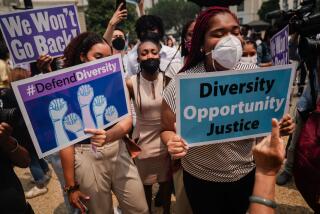Decisions May Lead to More Lawsuits
- Share via
WASHINGTON — The Supreme Court’s decision Monday narrowly upholding affirmative action clarified the law on the use of race in university admission decisions -- just enough to ensure years of lawsuits over how the ruling will be implemented and whether people other than school administrators ought to pay attention to it, observers on both sides of the issue said.
Civil rights groups said the ruling offers a road map to universities to construct affirmative action programs, and new life to some older plans. Among the latter: an affirmative action program at the University of Texas that was struck down by a federal appeals court. Popular initiatives, such as California’s Proposition 209, are also likely to come under scrutiny.
Affirmative action opponents who had seen the two University of Michigan cases decided Monday as a once-in-a-generation chance of winning a high court mandate against the practice are regrouping but say they see plenty of opportunity to attack affirmative action in individual cases.
The rulings could also have a bearing outside university doors, nudging private employers toward wider acceptance of affirmative action policies in hiring, training and promoting workers.
The court’s majority opinion cites the experience of corporations that have embraced affirmative action. And it states for the first time that an interest in diversity alone could be enough to justify giving advantages to members of one race over another, absent strict quotas.
In the past, such preferences were considered justifiable only where there was evidence of prior discrimination.
“I would view [Monday’s ruling] as moderately improving the outlook for a private employer or even a state employer that wanted to justify an affirmative action program,” said Leon Dayan, a Washington labor lawyer. “This case allows employers to put forward other rationales” beyond having to show that affirmative action was needed because minorities were underrepresented in the work force.
An employer operating in an area where the labor pool was overwhelmingly white could now make a legally defensible argument for an affirmative action plan to achieve the benefits of having a diverse workforce, Dayan said.
Other lawyers said municipalities without histories of discrimination now looking to boost the ranks of minorities could benefit from the ruling. Donald Livingston, another labor law expert in Washington, said proponents of affirmative action for fire and police departments may be emboldened by the court’s ruling because they can now argue that racial diversity is important to their mission of dealing with the public.
Even opponents of affirmative action acknowledged the decision could have broad consequences.
“Whenever the Supreme Court acts, even within the narrow confines of a decision pertaining only to education, there are going to be residual, spillover effects,” said Peter Kirsanow, a member of the U.S. Commission on Civil Rights, and a critic of affirmative action.
At the very least, he said, corporate lawyers are likely to urge clients to look to the Michigan cases for guidance in constructing affirmative action programs.
But other lawyers cautioned that care should be taken not to read too much into the opinion.
One of the most contentious areas in the affirmative action arena in recent years has been the practice of government agencies setting aside contracts for minority or disadvantaged groups. The Supreme Court put strict limits on the practice in a 1995 ruling, and the court indicated in its ruling Monday that it was not easing those limits.
The education arena alone should provide legal work for years to come.
“The court is groping for some sort of middle ground that is going to be very difficult to ascertain,” said Clint Bolick, vice president of the Institute for Justice, a libertarian Washington public-interest law firm that filed a friend-of-the-court brief in the case. “And that means lots of work for lawyers.”
Affirmative action opponents, he said, are likely to take the fight to the voters, in the form of ballot initiatives rejecting racial preferences along the lines of those adopted by voters in Washington state and California.
In addition, “public universities will try to push the envelope in terms of what they think they can do in terms of racial preferences,” Bolick said. “Each time they do, I think we will see a new assault in court.”
Other opponents said they intend to seize on language in the majority opinion urging universities to hold periodic review of affirmative action policies or include “sunset” provisions that put an end to the policies after a specified time.
“All the Supreme Court said was that the federal Constitution does not prohibit the use of race” in the admissions context, said Michael Rosman, general counsel of the Center for Individual Rights, a Washington advocacy group that represented the plaintiffs in the suits against the University of Michigan.
“That does not mean state legislatures or courts cannot prevent the use of race, or that federal legislatures cannot prohibit the use of race,” he said. “There are all sorts of ways that the people who overwhelmingly oppose the use of race can express their views.”
But affirmative action proponents said they thought their movement had been reborn by the decision.
Marisa Demeo, a spokeswoman for the Mexican American Legal Defense and Education Fund, said California and Texas, having discontinued affirmative action at public universities, “must reexamine and reform their policies and practices in light of this new Supreme Court guidance.”
A 1996 ruling by a federal appeals court that held the affirmative action plan at the University of Texas law school to be illegal is now “toast,” asserted Wade Henderson, executive director for the Leadership Conference on Civil Rights.
That ruling had given rise to a statewide university admissions policy that the Bush administration had touted as an ideal alternative to affirmative action.
The plan guarantees admission to a percentage of all the top students at state high schools regardless of race. But some groups said they now expect an effort to overhaul the system and revive a form of affirmative action there.
“I think this is a victory for higher education. I also think that the court gave a road map of how we can get to creating diversity,” said Martin Luther King III, president of the Atlanta-based Southern Christian Leadership Conference.
“We have not achieved true diversity in society as of yet, and we do not have a level playing field,” he said. “If and when there is a level playing field ... we will not have the need for such programs as affirmative action.”
More to Read
Get the L.A. Times Politics newsletter
Deeply reported insights into legislation, politics and policy from Sacramento, Washington and beyond. In your inbox twice per week.
You may occasionally receive promotional content from the Los Angeles Times.










